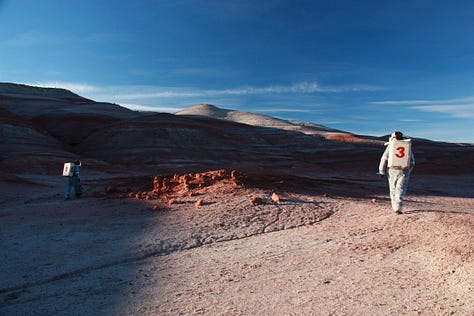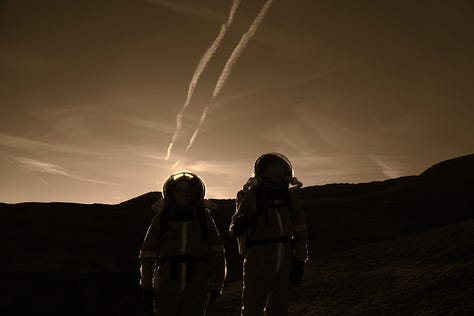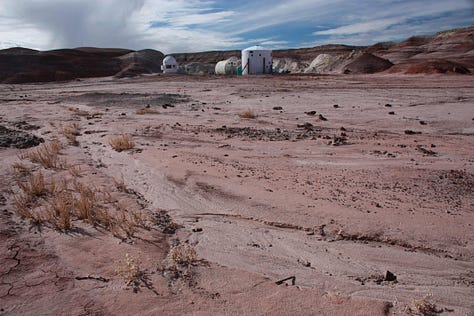The benefit of hindsight
Were humans changing the climate before the industrial revolution? (10 minute read)
Down a dusty four-wheel-drive track named North Cow Dung Road, just out of Hanksville, a town with 107 registered voters in the Utah desert, there’s a place where people go to imagine the future. The largest building looks like a fuel storage tank at a port – it’s a white-painted cylinder, with a heavy, metal door and a few small windows. The cylinder is known colloquially as “the hab”, short for “habitat” and it’s a simulation of what a base on Mars may be like. It’s part of the Mars Desert Research Station, and I spent two weeks there in 2013.
The Mars Desert Research Station is run by the Mars Society. Since it began operations in 2001 more than 1000 people have taken part in simulated Mars missions there. It’s used for all kinds of research, such as testing equipment in the Mars-like desert around the station, and what is known as ‘human factors’ research which is studying how people cope with being cooped up together in a small space and wearing space suits when going outside. Sometimes, people are there as part of their work. But often, participants are volunteers. When I was there, I was part of a crew which included two NASA scientists who had chosen to use their annual leave to do a bit of extra research and an engineer who usually worked on helicopters. She was studying how to control dust.



I brought a different set of skills to the mission. I knew little about Mars or space exploration before I went. Certainly, researching what life would be like on a Mars base was nothing to do with my work. The skills I brought were not futuristic. I was there to write about the mission (my contributions are the journalist reports and the greenhab reports on the page here). I was there to do the cooking. And I was there to grow plants.
Each of these skills is ancient. Writing is the newest – it dates back less than 5500 years. Cooking is the oldest of the skills. Although exactly when we first began to cook food is still debated, it was long before modern humans. Use of fire was widespread among our ancestors by 800,000 years ago, and we may have begun cooking food as much as 2.3 million years ago. We were baking bread 14,000 years ago, although risen breads came along many thousands of years later.
In the middle sits the skill of growing plants. Well before agriculture began, our hunter-gatherer ancestors had a detailed knowledge of how plants grew and reproduced. Modern hunter-gatherers manage the environment in various ways to make it produce more food and there is evidence that early people did too. We can’t be sure when they first began cultivating plants, that is, taking seeds or tubers from useful plants and using them to grow more of that plant. So far, the earliest evidence for some limited cultivation of grain species dates back 23,000 years.
I’d never thought about the origins of agriculture until I did a paper in anthropology at university, more than thirty years ago. What I learned then astounded me. Although we have learned a lot since that time, the basic, mindblowing facts have not been updated.
Agriculture is not something that was invented in one part of the world and then spread to other places. It developed independently in at least 14 different places, perhaps as many as 23, with different plant and animal species. And this all happened at around the same time. Modern humans have existed for 300,000 years. But the transition of societies in the Near East, Africa, East Asia, North, Central and South America and New Guinea to agriculture began over a period of 4000 years, from around 12,000 years ago to 8000 years ago.
The development of agriculture was more than just collecting seeds and putting them in the ground. It was a process of changing plants and animals from their wild ancestors into domesticated species which better served human interests. Before agriculture developed, humans had domesticated one species, the dog, which was domesticated around 15-17,000 years ago. But beginning around 11,700 years ago, grass species appear with larger seeds which remain attached to the stem when ripe. The latter trait is crucial – normally a grass seed head breaks apart when the seeds are ripe, so that they land on the ground and grow new plants. But humans who harvest seeds for food want those seeds to remain attached to the plant, so that they are easier to collect. If archaeologists find evidence of grasses which retain their ripe seeds, they’ve found evidence for domestication.
In the area around the Tigris and Euphrates Rivers in modern-day Iraq, the species which are found include wheat and barley. In the area around the Yellow River in modern China, the species are rice and a type of millet. In West Africa, it’s another type of millet known as pearl millet. In Central America, it’s maize.
But it wasn’t only plants we were domesticating. Cattle, sheep, goats and pigs were all domesticated around that time too. Cattle are particularly interesting, because the different types of cattle are not different breeds which come from the same ancestors, like dogs. African cattle breeds were domesticated from African cattle (although there is some debate about this), the cattle domesticated in the Near East (which later spread to Europe and Africa) were bred from local wild cattle, and South Asian cattle were domesticated from wild breeds there. Later, there were two more cattle species domesticated in South and East Asia, as well as two types of water buffalo and yak. All told, we have domesticated at least 24 livestock species, not counting species like dogs and cats.
Until comparatively recently, western scientists (and lay people) held the view that the development of agriculture was part of the inevitable march of progress from uncivilised to civilised (to be fair, some still hold this view as far as I can tell). However, in the 1960s some more open-minded research on the lives of people who lived as hunter-gatherers revealed that they spent less time working to satisfy their material needs than agricultural people (or indeed the average office worker). Their lives were not precarious and impoverised, as prejudiced modern eyes had judged.
This realisation ignited a debate – if life was good for hunter-gatherers, why did so many people, in so many parts of the world, turn to agriculture? More than 50 years on, the debate is still not settled. The advantage that agriculture has is that it can sustain more people on the same amount of land, albeit at a cost of more work and with more frequent famines. But the archaeological evidence doesn’t support the idea that agriculture developed because of population pressure, and it doesn’t explain why it happened all around the world at around the same time.
One important factor seems to be the climate. It’s unlikely to be accidental that agriculture developed as the Earth emerged from an ice age. But how climate played a role is less certain. Some have suggested that it was because the conditions of the time were more favourable to plant growth than the previous 100,000 years – it was warmer, wetter and with higher atmospheric carbon dioxide. Some researchers have proposed that agriculture requires a period of sustained stable climate to develop, and that for the previous 50,000 years the climate had not been stable enough.
Another hypothesis with some support, at least for the Americas, is that the transition was driven by the extinction of megafauna. Megafauna simply means ‘large animals’, such as elephants or giraffes, but there used to be many more species. We aren’t sure why so many became extinct over the previous 50,000 years, but it’s thought to have been human hunting, climate change or a combination of the two. When the megafauna became extinct, humans lost a valuable source of food, and one possibility is that they turned to agriculture as an alternative. It’s also likely that agriculture was easier without herds of giant herbivores roaming the landscape.
There are other ideas too. Some have suggested that early adopters of agriculture gained a material advantage over their hunter gatherer neighbours. Others have noted that when people began growing crops, there was less time for hunting and foraging, and that an increasing population would have put pressure on foraged resources. Within a relatively short time, it might have become difficult to revert to hunting and gathering, even if people wanted to.
Even before we began farming, humans were burning off forest to create environments better-suited to hunting and foraging. But there were only around one to ten million of us back then. By 7000 years ago, when agriculture had well and truly taken hold, the figure was closer to 20 million. By 5000 years ago, still 500 years before the main structure of Stonehenge was built, there were more than 40 million. These figures still sound tiny in comparison with the start of the Industrial Revolution, when there were more than a billion of us. However, in those early days, we used much more land per person to grow our food. We were causing deforestation on a large scale. This deforestation was seen all around the world, in Africa, Europe, Asia and the Americas.
We tend to think of human-caused climate change as an impact of modern, industrial societies, but over the last 20 years, the evidence has been growing that we were causing climate change long before we started burning fossil fuels. It’s not obvious in the graphs we use today, because early changes have been eclipsed by the massive spike in carbon dioxide since 1850. But from around 8000 years ago, carbon dioxide levels in the atmosphere began to rise, from 260 to 280 parts per million around 2000 years ago. Methane emissions also began to rise from around 5000 years ago, from around 600 to 700 parts per billion. Globally, the temperature rose by around 0.8oC, and 2oC at higher latitudes.
Both the size and time scale of these increases fit within the range of natural fluctuations, so how do we know humans caused them? For many years, it was assumed that there were simply too few humans for this to be the result of human activities. But the changes over the last 8000 years go against long-term trends – they are counter to the Milankovitch cycles which influence how much sunlight the Earth receives. More detailed analysis has shown that the increase in carbon dioxide was largely the result of deforestation and the methane emissions resulted from greater numbers of livestock and the development of paddy rice cultivation.
Even changes seen over shorter time periods have been linked to human activities. The Little Ice Age was a period of global cooling from around 1400 until 1850. Just prior to the Little Ice Age, a third of Europe’s population died from the Black Plague. A hundred years later, there was a massive drop in the population of the Americas, from maybe around 60 million to around 6 million, due to the arrival of Europeans and their diseases. Both events saw vast areas of agricultural land reverting to forest, drawing more carbon dioxide from the atmosphere and cooling the climate.
The scale of climate change that humans caused prior to 1850 is tiny compared to what we are doing today. But these events in our past do show how sensitive the Earth’s climate is to our actions.





Excellent post, Melanie—lots of important and fascinating information!
Melanie this is a well produced piece, that helps to put our sorry planet's history into clear perspective.
More intelligent than doom scrolling initiated moaning, and an arrow to thinking clearly about solutions. I believe that we, the writers have a duty to prompt such thinking, and I perceive a growing trend here. A trend that some of us are attempting to accelerate. Perhaps this will interest you....
https://suzannetaylor.substack.com/p/an-essay-contest-its-january-1-2050 Peace, Maurice